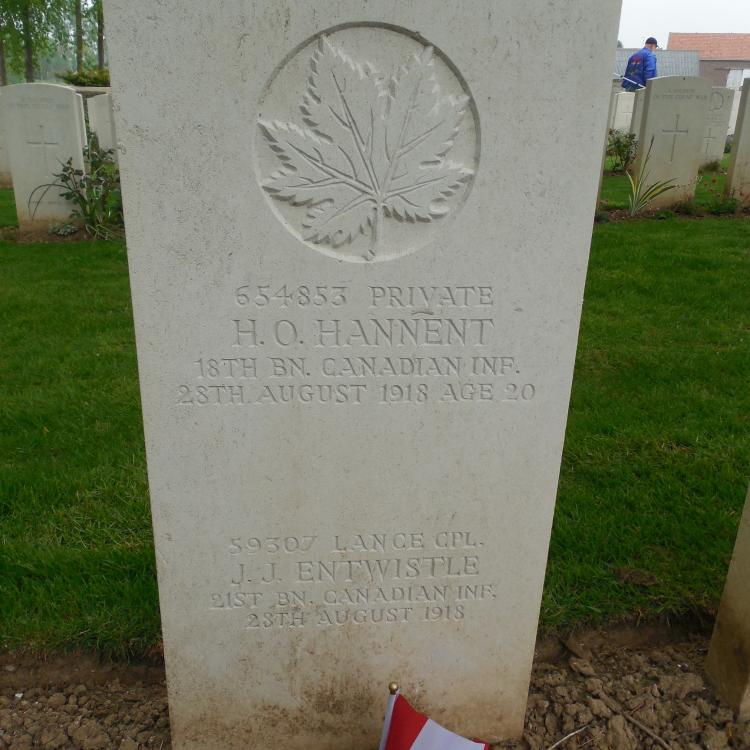HANNENT, Oxley Harold Jr.
DIVISIONAL UNIT: 2nd Canadian Infantry Division
4th Infantry Brigade
18th Battalion - Western Ontario
Canadian Infantry Corps
SERVICE NO: 654853
RESIDENCE Clinton – Ontario
DATE OF BIRTH: January 12, 1898
Norfolk – Norwich - England
DATE OF DEATH: August 28, 1918 20 years 7 months
CEMETERY: Vis-en-Artois British Cemetery – Vis-en-Artois –
Pas de Calais – France.
II A 11
PARENTS: Mr. Oxley Harold and Alice Emily Hannent – London – Ontario.
Occupation: Farmer. Religion: Church of England.
Enlistment: Cinton – May 20, 1916 – 161st Huron Battalion.
Enlistment Age: 18 years. 4 months
Private Hannent arrived in England during the Month of November 1916 and on March 28, 1918 he was transferred to the 18th Battalion and left for France. He arrived at the Canadian Base Depot at Etaples and arrives at the reinforcement camp on April 3, 1918 and from there joined his unit already in the field on April 16, 1918.
Private Hannent was killed in action at Vis-en-Artois. The diary of the Battalion states the coming attack was to begin an noon and the 18th Battalion would be behind the 21st Battalion as support. As they advanced forward toward the slope of the Senssee River heavy casualties were taken from the enemy artillery and machine guns and as a result were forced to withdraw to a sunken road fronting the enemy fire and barbed wire.
The Brigade diary says the weather was fine and warm.
The 18th Battalion was behind the 21st Battalion as support. The previous two days had been long and bloody with nothing but bitter and intense fighting taking place. On the morning of the August 28th the order was given to continue the advance with the support of artillery. The 4th Brigade was left support and had a front of 700 yards with the east being on the Arras-Cambrai road. Shortly after noon the advance began and so did the artillery barrage – they were able to cross the Senssee and go to Olive Trench and Ocean Works. Here the Germans had good observation and while advancing met heavy machine gun and artillery fire. Many casualties were suffered and the advance stalled because the barbed wire in front of the enemy lines had not been cut and the men were getting hung up on it.
Artillery was again brought down on Olive / Cable Trenches and an S.O.S.line was formed along the front and for a long period the men had to occupy shell holes. Later a line of posts was established well in front of the Senssee with the posts using sunken roads and banks as cover.
For the last three days, the casualty count was 310 men either killed or wounded and missing.


